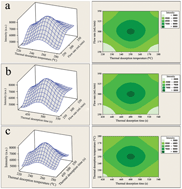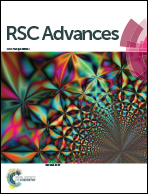A novel and highly sensitive gaseous n-hexane sensor based on thermal desorption/cataluminescence†
Abstract
A novel and highly sensitive sensor for gaseous n-hexane utilizing the sensing material Y2O3–Al2O3 (mass ratio of 2 : 1) has been developed based on the thermal desorption/cataluminescence (TD/CTL). Firstly, the cataluminescence characteristics of the above sensor were investigated. Then, the optimal conditions of the developed sensor for the determination of n-hexane were analyzed using response surface methodology (RSM). When the sensor was performed at the optimal catalytic temperature (Tc) of 200 °C and the wavelength of 400 nm, the linear range was 1.32–132 mg m−3 with a detection limit of 0.4 mg m−3. In addition, there was little to no response when contaminating volatile substances including benzene, toluene, chloroform, ethanol, and cyclohexane were passed through the sensor. This proposed TD/CTL-based n-hexane sensor shows high sensitivity, good stability, and rapid response and allows real time monitoring of n-hexane in air.


 Please wait while we load your content...
Please wait while we load your content...